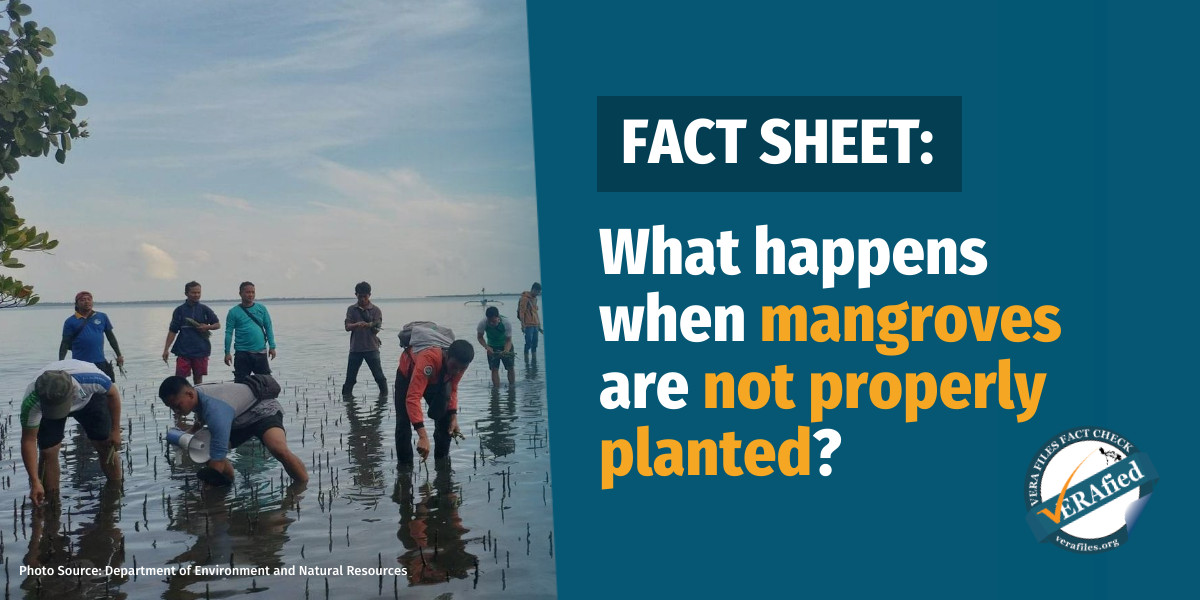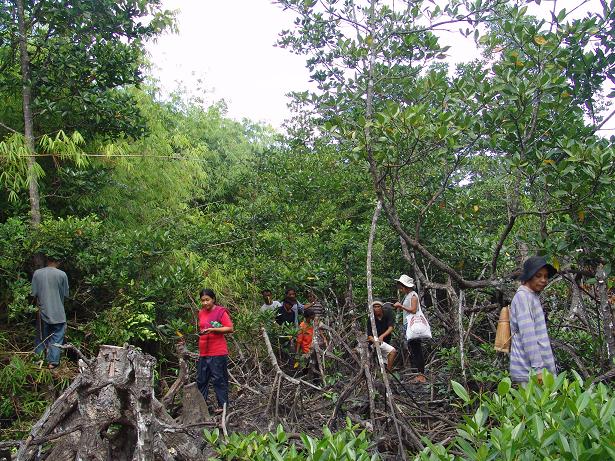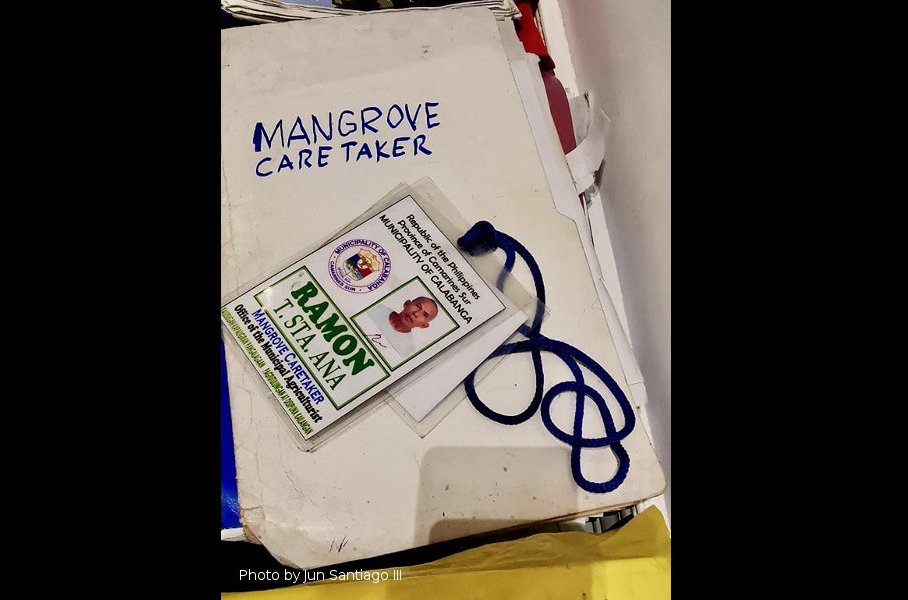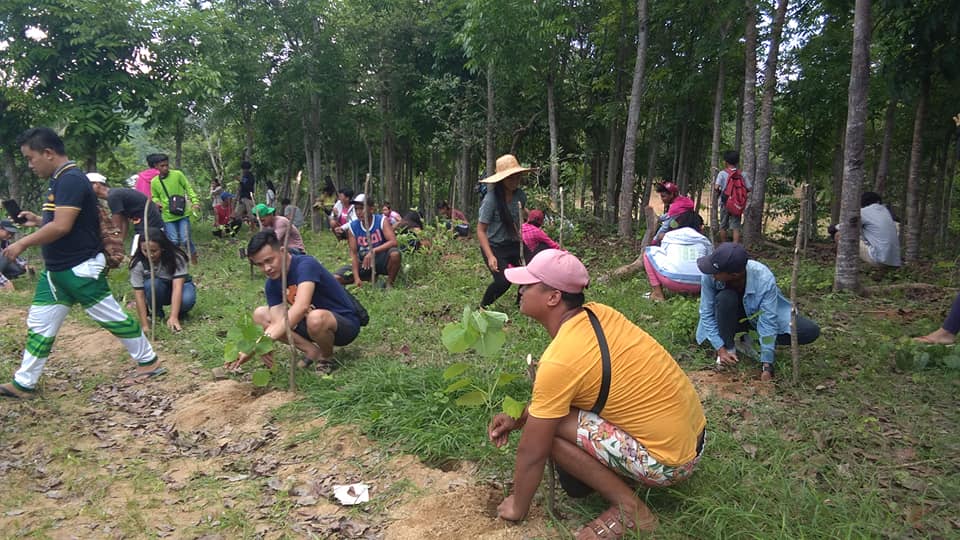On June 1 and 6, the local offices of the Department of Environment and Natural Resources (DENR) in Bohol and Negros Occidental drew flak from environmental advocates for improper planting of mangroves.
This was not the first time advocates called out the DENR for its “unscientific” method.
Why does proper planting of mangroves matter? Here are some important facts you need to know:
1. Why plant mangroves?
The DENR defines mangroves as a group of trees and shrubs that thrive along tidal mudflats and shallow water coastal areas and can extend inland along rivers, streams and headwaters. These grow only in tropical and subtropical areas because they cannot withstand freezing temperatures.
Mangrove forests are known to have ecological benefits, serving as natural barriers against storm surges, coastal erosion and coastal flooding, as well as habitats and food sources for wildlife.
More importantly, they act as “carbon sinks” that reduce greenhouse gas emissions, which are the main driver of climate change.
“Our mangroves combat climate change by storing huge amounts of atmospheric carbon. For example, we have fossil fuel industries from the transportation industry. Of course, they emit a lot of carbon. Most of this carbon is actually stored within the soils of the mangroves,” Matthew Tabilog, founder of Mangrove Matters PH, said in an interview with VERA Files.
Tabilog added that mangrove forests are good sources of food and livelihood for communities living in coastal areas.
However, from the estimated 500,000 hectares in 1918, the country’s mangrove cover has dwindled to about 118,000 in 1995 due to fishpond conversion, reclamation projects and other industrial developments. Latest data show that the current mangrove forest cover in the Philippines is approximately 310,000 hectares.
This mangrove deforestation has made the country and its coastal communities, which are already prone to typhoons, more vulnerable to damage brought by storm surges and flooding.
In 2017, a study conducted through WAVES, a partnership program led by the World Bank, showed that without mangroves, flooding and damage to people, property and infrastructure in the Philippines would increase annually by approximately 25%.
It added that the country’s current mangrove cover prevents 613,000 more people from being flooded annually and saves more than US$1 billion (about P56 billion) in damages to residential and industrial property.
The continued erosion of these forests prompted environmental advocates and the DENR to campaign for mangrove reforestation and conservation.
2. What is the proper way of planting mangroves?
Discussing photos of DENR’s mangrove planting projects posted on social media, Tabilog pointed out that the wrong species were used in the wrong zone.
He explained that proper mangrove zonation is vital in achieving a high survival rate as it indicates which mangrove species can better survive in seaward, midward or landward areas.
“From the photos that we’ve seen sa DENR, may mga existing (there are existing) Sonneratia and Avicennia na na mangroves. So from that point alone, they should have planted those specific species in that specific area. Kasi ‘yung mga (Because) Rhizophora na mga mangroves, they thrive mostly in the midward zones,” he explained.
Aside from proper zonation, Tabilog said it is important to know the different conditions in planting mangrove seedlings.
For one, he said, seedlings should be one meter in height to withstand coastal conditions. Second, it is best to plant them during summer because the rainy season makes these seedlings more vulnerable to being wiped out.
Tabilog described DENR’s mangrove method as “planting by convenience.” This is because Rhizophora seeds can be planted directly while Sonneratia and Avicennia should be first developed in nurseries.
“Maliit kasi ‘yung seeds ng Sonneratia at Avicennia. So, if you want to plant them, normally may mga mangrove nurseries, it takes a lot of time for them to develop pa… ‘Yung sa Rhizophora, ‘yung seeds nila ay germinated na kahit attached pa siya sa parent tree. So, it means, once it goes down, pwede mo na siyang ma-plant,” he explained.
(Sonneratia at Avicennia seeds are small. So, if you want to plant them, normally there are mangrove nurseries. It takes a lot of time for them to develop… As for Rhizophora, their seeds are already germinated even if they’re still attached to their parent tree. So, it means, once it goes down, you can directly plant them.)
Tabilog emphasized the importance of conducting ocular visits before starting any mangrove planting projects to see what species are already thriving in the area and the soil condition.
“Kasi (Because) you plant mangroves tapos ‘di mo alam (but you don’t know) it’s a habitat for crustaceans or barnacles na very susceptible sila sa survival nila (that they are very susceptible for their survival). Of course, we also need to conduct proper protocols to plant mangroves para (to) at least ma-achieve ‘yung (achieve the) survival rate,” he explained.
3. What are the consequences of improper mangrove planting?
“Our No. 1 consequence is that we won’t be able to achieve our ultimate goal of planting mangroves, which is to achieve a higher survival rate. It will be ultimately wasteful to our resources, to our time, if we conduct this improper waste of mangroves,” Tabilog said.
He added that planting certain mangrove species in the wrong areas may disrupt existing ecosystems, stressing that conducting mangrove planting projects near seagrass beds should be stopped.
“The thing is when they plant mangroves sa (in) seagrass beds, ‘yung (the) roots kasi ng (of) mangroves, they are so extensive. So, it could ultimately damage the seagrass beds. And to think na ‘yung (that the) seagrasses, these are nursery grounds for commercially important fishes,” he explained.
“They don’t understand na (that) seagrasses are another ecosystem that also needs to be protected because they’re also vulnerable to climate change, they’re also vulnerable [to] coastal reclamation, they’re also vulnerable [to] anthropogenic factors,” Tabilog added.
He emphasized the role of the community in making sure that these reforestation projects are sustainable and effective.
To prevent these mistakes from recurring, he said the DENR and other organizations planning to conduct their own mangrove planting activities should first consult experts and, more importantly, the fisherfolks and communities in the area.
“I’ve learned a lot by immersing [myself in] the communities. Some people would think ‘yung mga (the) communities, they don’t know anything at all. Well, actually they do have. They have indigenous knowledge… So, it’s also high time that we listen to them, aside from listening to experts, because they know so much about the environment that they are living [in],” he said.




